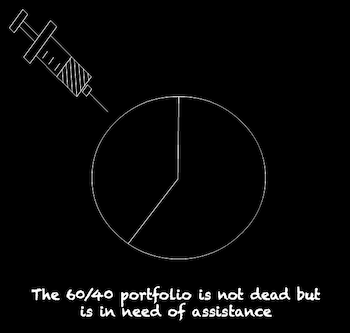The first page of a Google search for the 60/40 portfolio suggests we have a problem. The headlines claim the 60/40 may need to be ‘rethought’ or ‘may not have a future’. It is no longer ‘good enough’.
So is the 60/40 portfolio dead? Dying? Should you jump ship if you’re sitting in the Vanguard LifeStrategy 60 or some other variant of the 60/40?
Well, there is certainly blood in the water.
As with any online feeding frenzy, the media sharks have sniffed out a few molecules of truth. But the meal they’ve made out of it is a clickbait chowder spiced by unsubstantiated opinion. Washed down with poor advice.
So let’s set aside those empty calories and chew on the heart of the matter.
There are reasons to be fearful. Today we’ll discuss the magnitude of the problem. In part two we’ll walk-through potential remedies.
What is a 60/40 portfolio? The classic 60/40 portfolio is named for its strategic asset allocation that splits into 60% equities and 40% bonds. The equity portion positions investors to benefit from the long-term growth prospects of global stock markets. The inherent risk of equities is offset by a diversifying allocation into high-quality government bonds. The underlying rationale for the 60/40 portfolio was provided by Modern Portfolio Theory. The split soon became a default solution for financial advisors, workplace pension schemes, and DIY investors. The simplicity, historical record, and widespread acceptance of the 60/40 makes it a useful compromise. The allocation puts investors in a reasonable spot on the risk vs reward spectrum – but without exposing the finance industry to accusations of negligence in the event of shortfall or failure.
60/40 portfolio problems
There are good reasons to think the 60/40 portfolio may be under-powered in the current environment.
High stock market valuations have historically been correlated with weaker future returns five to ten years out.
The US stock market dominates global indices. And it keeps pushing into nose-bleed territory – at least according to valuation metrics such as the cyclically-adjusted price-to-earnings (P/E) ratio (CAPE).
Meanwhile, current government bond yield-to-maturities are typically taken to be an indicator of future returns. (The correlation tends to be highest around the seven to ten-year maturity mark).
Bond yields today are still super low.
Taken together, rich valuations for US equities and negative bond real yields (that is, negative after inflation), do not augur a bountiful decade for the 60/40 portfolio.
Managing expectations
The financial industry flashes these warnings about the future via the concept of expected returns.
Usually this takes the form of a 10-year forecast of average annualised returns.
And currently those numbers fall short of the 60/40 portfolio’s historical return.
The predictions look worse still when compared to the golden age of the past decade.
How much worse? In the next two sections:
- I’ll compare the expected returns estimates from some respected sources.
- I’ll show you how to calculate your own expected returns.
- We’ll conclude by talking about how accurate these prophecies are. (Spoiler Alert! Not very).
Expected returns prophesise gloom for the 60/40 portfolio
Below are three forecasts of expected returns for the 60/40 portfolio from credible industry sources. The numbers are 10-year annualised real returns, except where noted.1
Vanguard expected return: 2.6%. (4.6% nominal)
Note that 4.6% is Vanguard’s median nominal expected return for a global portfolio (bonds are 70% US Treasuries). I’ve derived the 2.6% real return by subtracting a 2% annual inflation guesstimate.
Dimson, Marsh, Staunton expected return: 1.6%
The renowned financial professors don’t say what their forecasted range is, or indicate portfolio composition. I’ve previously seen their forecasts predicated on a 20-30 year range, with developed world equities and 20-year gilts.
Research Affiliates expected return: 0.58%
Research Affiliates is a fund manager specialising in risk factor investing. I calculated the number from their expected return tool, based on global equities and gilts.
Do it yourself return hand-waving forecasting
Don’t like these numbers? Then you can calculate your own expected returns for the 60/40 portfolio…
First, let’s compute returns from the equity side of the portfolio.
Step 1 – Use an accepted valuation metric such as the Gordon Equation.
Step 2 – Grab the current dividend yield of the fund that’s the mainstay of your portfolio. (Or the weighted figure for every fund if you want to be super-precise. But it’s probably not worth it.)
For example: the dividend yield (at the time of writing) of the Vanguard FTSE All-World ETF = 1.38%
Step 3 – Add the dividend yield to a consensus real earnings growth number. I’m plugging in 1.4% for the latter, for reasons explained in the Gordon Equation article I linked to above.
So: 1.38% + 1.4% = 2.8% expected annualised return for the equity side (10-year, real return).
Now, let’s do the bonds. They’re even easier.
Step 1 – Get the 10-year gilt yield from FT.com.
Step 2 – That yield is nominal so make it real by subtracting an educated guess about annual average inflation rates.
Again: 1% (10-year gilt yield at time of writing) – 2% (my inflation rate guess) = -1% expected annualised return for the bond side (10-year, real return).
Our 60/40 portfolio’s expected return is the weighted sum of our equity and bond numbers.
- 60% equity allocation = 2.8 x 0.6 = 1.68%
- 40% bond allocation = -1 x 0.4 = -0.4%
Our portfolio expected’s return = 1.28%
Remember that’s an annualised, 10-year, real return.
Many unhappy returns
We now have a range of expected returns:
- 2.6% – Cheers Vanguard!
- 1.6% – The middle-ground from Dimson, Marsh, Staunton.
- 1.28% – We’re glass half-full types at Monevator.
- 0.58% – Research Affiliates is perma-pessimistic on vanilla securities.
The historical average real return for the 60/40 portfolio is 3.4%. Our middle ground forecast cuts that by more than half. That’s not good news.
And it gets even worse if you anchor to the last decade.
The Vanguard LifeStrategy 60 fund is a 60/40 portfolio that delivered 8.9% annualised over the past ten years.
That’s a nominal return. Let’s call it 6.5% after inflation. That’s almost double the historical return!
We hope you enjoyed the ride.
Could the expected return predictions be wrong?
Yes! The one thing you can expect from expected returns is that they will be wrong.
I rounded-up some 2012 and 2013 forecasts in a ye olde Monevator post.
None came close to predicting 6.5% annualised returns for the decade ahead:
Sure, the ten years isn’t up. But in some cases there’s only months to go.
Moreover, these predictions weren’t typically saddled with UK bias or fund fees, unlike the Vanguard LifeStrategy 60.
My co-blogger The Investor can’t resist reminding me that he struck a more optimistic tone when writing in 2012.
But was he skillful, lucky, or is he cherry-picking his prognostications?
Maybe a bit of all three. After all, Vanguard’s research team analysed the predictive power of 15 equity forecasting metrics. They found that the best (CAPE) only explained 43% of the variance in future returns ahead of time.
Thus even CAPE left 57% of the variation unexplained.
It all means expected returns are about as reliable as UK weather forecasts.
At least they remind us that it might rain, so we should pack a brolly as well as our sunnies.
Similarly, we should not blindly assume that the glorious returns of the last decade can carry on. Especially as the downside signals are even more pronounced now than they were ten years ago.
The Bank of England expects
You could argue the expected returns circulating ten years ago were too cautious. But we couldn’t know that at the time. The process was right, despite the outcome.
The warnings today also come from credible figures. They are worth taking seriously, whatever the uncertainty.
Surprises can come in nasty flavours as well as nice. It might turn out that Research Affiliates’ 0.58% is closer to the mark than Vanguard’s 2.6%.
There’s also no law that prevents a 60/40 portfolio losing money for ten years or more.
If you’re spooked, what countermeasures can you take that aren’t counter-productive?
I’ll go through some sensible options in the next post on the 60/40 portfolio.
Suffice to say, there are some terrible ideas being spread around by big media brands. It’d be better if they made a genuine effort to help people.
Take it steady,
The Accumulator
- Real returns subtract inflation from your ‘nominal’ investment results. Real returns are a more accurate portrayal of your capital growth in relation to purchasing power than standard nominal returns. [↩]







